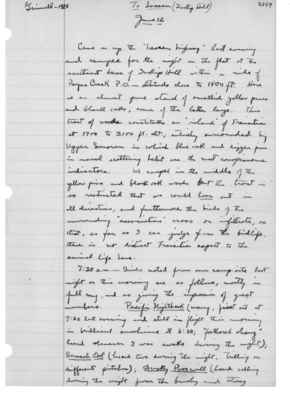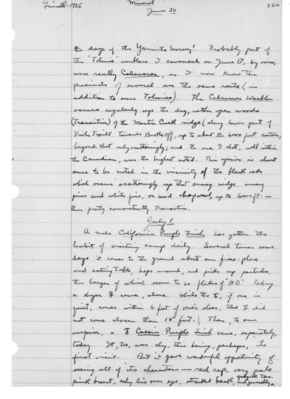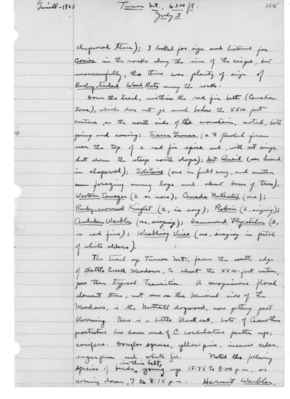Pages That Mention black oak
1925: Joseph Grinnell's field notes
S2 Page 3
Collector: Grinnell - 1925 Location: To Lassen (Inskip Hill) Date: June 12, 1925 Page Number: 2459
Came on up the "Lassen highway" last evening and camped for the night on the flat at the southeast base of Inskip Hill within a mile of Payne Creek P.O. - altitude close to 1800 ft. Here is an almost pure stand of smallish yellow pines and black oaks, some of the latter large. This tract of woods constitutes an "island" of transition at 1700 to 2100 ft. alt., entirely surrounded by Upper Sonoran in which blue oak and digger pine in usual scattering habit are the most conspicuous indicators. We camped in the middle of the yellow pine and black oak woods but the tract is so restricted that we could hear out in all directions, and furthermore the birds of the surrounding "associations" cross or infiltrate, so that, as far as I can judge from the birdlife, there is no distinct transition aspect to the animal life here. 7:30 a.m. - Birds noted from our campsite last night or this morning are as follows, mostly in full song, and so giving the impression of great numbers. Pacific Nighthawk (many, first out at 7:20 last evening and still in flight this morning in brilliant sunshine at 6:30; "feathered whang" heard whenever I was awake during the night); Screech Owl (heard two during the night, trilling in different pitches); Dusky Poorwill (heard calling during the night from the bushy and stony
S2 Page 34
Collector: Grinnell-1925 Location: Mineral Date: June 22 Page Number: 2489
sitting closely, nearly touched before she flew off. Nest 1750 mm out to south of trunk of cedar, which is a small tree, 8 in. diam., growing beneath sugar pine and white fir. Taken; incubation of eggs ^well begun. (1/4).
8:05 a.m. - Mt. Chickadee's nest, with well-feathered young, in old woodpecker (?) hole in barkless broken-off pine stub 2 ft. in diam.; lower edge of entrance, 1950 mm. above ground. Diam. of entrance 40 mm.; ^38 mm. nest diam.; Both old birds are bringing food to young.
Just followed up a song which puzzled me. The producer would stay ^still, perched 75 to 100 feet up in firs or yellow pines. Sang a sustained, vigorous, dry trill, but dropping toward end. Quietly chipping sparrow like, but this falling at the end made me suspect an orange crowned warbler. The bird, finally seen clearly, was a Chipping Sparrow.
One or more Golden-crowned Kinglets in a clump of young fir. A Solitaire "creaking" in the distance. A Pileated Woodpecker, flying thru the woods, giving its resonant "Kuk" slowly and irregularly in a long series. At least two singing Calaveras Warblers on this dry ridge in vicinity of some smallish black oaks, but singing from all sorts of places, up to 75 feet up in firs and cedars. Tho Ch Calif. Purple Finches in full song nearby.
10:12 a.m. - Solitaire's nest, on level of ground inside a cavity (old burn) in base of ^living sugar pine 2 1/2 feet in diameter. The four young are wholly
S2 Page 59
Collector: Grinnell - 1925 Location: Mineral Date: June 30 Page Number: 2512
the days of the Yosemite Survey! Probably part of the "Tolmie" warblers I censused on June 17, by voice, were really Calaveras, as I now know the precincts of several over the same route (in addition to some Tolmies). The Calaveras Warbler occurs regular up the dry, rather open woods (Transition) of the Martin Creek ridge (along lower part of Viola Traill towards Brokeoff, up to about the 6000 foot contour; beyond that only scatteringly; and the one I shot, well within the Canadian, was the highest noted. This species is almost sure to be noted in the vicinity of the black oaks which occur scatteringly up that sunny ridge, among pines and white firs, or mid chaparral, up to 6000 ft. thus pretty consistently transitional.
July 1 A male California Purple Finch has gotten the habit of visiting camp daily. Several times some days it comes to the ground about our fire-place and eating table, hops around, and picks up particles, the larger of which seem to be flakes of "H O". Today a shyer [female symbol] came, alone. While the [male symbol], if one is quiet, comes within 6 feet of one's shoes, the [female symbol] did not come closer than 15 feet. \ Then, to our surprise, a [male symbol] Cassin Purple Finch came, separately, today. It, too, was shy, this being, perhaps, its first visit. But it gave wonderful opportunity of seeing all of its characters - red cap, very pale pink breast, ashy line over eye, streaked beak, and generally ^grayish tone.
S2 Page 65
Collector: Grinnell - 1925 Location: Turner Mt., 6300 ft. Date: July 3 Page Number: 2518
chaparral there); I looked for sign and listened for Conies in the rocks along the rim of the cirque, but unsuccessfully, tho there was plenty of sign of Bushy-Tailed Wood Rats among the rocks.
Down the trail, within the red fir belt (Canadian Zone), which does not go much below the 5500 foot contour, on the north side of the mountain, noted, both going and coming: Sierra Grouse (a [male symbol] flushed from near the top of a red fir spire and, with set wings, shot down the steep north slope); Mt. Quail (one heard in chaparral); Solitaire (one in full song, and another seen foraging among logs and about bases of trees); Western Tanager (2 or more); Canada Nuthatch (one); Ruby-crowned Kinglet (2, in song); Robin (2, singing); Audubon Warbler (one, singing); Hammond Flycatcher (2, in red firs); Warbling Vireo (one, singing in patch of white alders).
The trail up Turner Mt. from the south edge of Battle Creek Meadows, to about the 5500-foot contour, goes thru [sic] typical transition. A conspicuous floral element there, not seen on the Mineral side of the Meadows, is the Nuttall dogwood, now getting past blooming. There is a little black oak, lots of Ceanothus prostratus low down and of C. cordulatus farther up; conifers: Douglas spruce, yellow pine, incense cedar, sugar pine, and white fir. Noted the following species of birds ^in this belt, going up 12:45 to 3:00 p.m., or coming down, 7 to 8:15 p.m.: Hermit Warbler,



